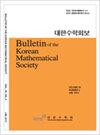在dedekind和的分母上
IF 0.5
4区 数学
Q3 MATHEMATICS
引用次数: 2
摘要
众所周知,Dedekind和式的分母s(c, d)除以2 gcd(d, 3)d,并且不存在独立于c的更小的分母。相反,这里我们证明在S(H, d)中我们通常得到一个更小的分母,S(c, d)除以乘群(Z/dZ) *中n > 1阶子群H中所有c的和。首先,我们证明了对于p bbb3a素数,和2S(H, p)是与(p−1)/2具有相同奇偶性的有理数。将这一结果应用于本源导体虚阿贝尔数场的相对类数上界。最后,我们给出了非必然素数d的S(H, d)的分母的一般结果。我们证明了它的分母是2d gcd(d, 3)的某个显式因子的一个约数。本文章由计算机程序翻译,如有差异,请以英文原文为准。
ON THE DENOMINATOR OF DEDEKIND SUMS
It is well known that the denominator of the Dedekind sum s(c, d) divides 2 gcd(d, 3)d and that no smaller denominator independent of c can be expected. In contrast, here we prove that we usually get a smaller denominator in S(H, d), the sum of the s(c, d)’s over all the c’s in a subgroup H of order n > 1 in the multiplicative group (Z/dZ)∗. First, we prove that for p > 3 a prime, the sum 2S(H, p) is a rational integer of the same parity as (p−1)/2. We give an application of this result to upper bounds on relative class numbers of imaginary abelian number fields of prime conductor. Finally, we give a general result on the denominator of S(H, d) for non necessarily prime d’s. We show that its denominator is a divisor of some explicit divisor of 2d gcd(d, 3).
求助全文
通过发布文献求助,成功后即可免费获取论文全文。
去求助
来源期刊
CiteScore
0.80
自引率
20.00%
发文量
0
审稿时长
6 months
期刊介绍:
This journal endeavors to publish significant research of broad interests in pure and applied mathematics. One volume is published each year, and each volume consists of six issues (January, March, May, July, September, November).

 求助内容:
求助内容: 应助结果提醒方式:
应助结果提醒方式:


